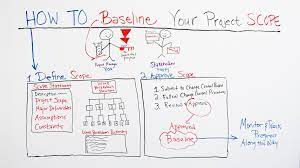Are What Is A Baseline In Project Management you new to the world of project management and wondering what exactly is a baseline? Or, are you a seasoned project manager who wants to refresh your knowledge on this critical aspect of successful projects? Regardless of your level of experience, understanding baselines in project management is crucial for achieving success. In this blog post, we will break down everything you need to know about baselines and how they can help you keep your projects on track. So let’s dive in!
What is a Baseline?
Baselines are important in project management because they help track progress and ensure that tasks are completed on time and within budget. A baseline is a reference point against which future changes can be measured. Typically, baselines consist of a set of agreed-upon conditions or requirements from which work is started. As work progresses, the baseline may need to be modified in order to reflect the new conditions.
Baselines can be used to manage risks as well. If work does not meet the baseline, it may signify that risk has been created and corrective action should be taken. This information can then be used to create contingency plans or lineItem budgets, depending on the type of project being undertaken.
There are many different types of baselines, but some common examples include: product features (e.g., requirement definition), software releases (version 1, version 2), customer contracts (specifications), and process performance indicators (e.g., cycle time). When creating baselines, it is important to consider the following factors: stakeholder involvement, Scope creep, and Continuity of effort/commitment.
Why is it important to have a Baseline?
A baseline is an important element in any project. It helps to ensure that progress is being made in the right direction and that tasks are being completed on time. Without a baseline, it can be difficult to track the progress of a project.
A baseline can also be used to measure how well the project is performing. You can use it to compare current performance with planned performance, and make necessary adjustments if necessary.
Creating a baseline is important for several reasons. First, it ensures that all necessary tasks are being completed on schedule. Second, it helps you to track progress and make modifications as needed. Finally, if the project falls behind schedule, you can use the baseline as a guide to catch up.
How to create a Baseline
In project management, a baseline is a summary of the current state of a project. It is used to track progress and identify changes that need to be made.
To create a baseline, first create a plan document for your project. This document should include information such as the goals of the project, the deadlines, and the resources required. Once you have created your plan, begin collecting data about your project. This data can include things like task lists, files created, and comments from stakeholders.
Once you have collected data from all sources, compile it into a baseline report. The report should include an overview of your project status at the beginning and end of the data collection period. You may also want to include graphs or charts to show how progress has changed over time.
Use the baseline report to make changes to your plan as needed and track progress updates on a regular basis.
How to use a Baseline in Project Management
Baselines are important tools in project management. A baseline is a set of expectations or goals that help you measure progress and make better decisions. A baseline can be used to track progress on projects, determine when milestones have been achieved, and identify areas where improvement is needed.
To create a baseline, first determine what you want to achieve. Consider the following questions:
-What are the project’s overall goals?
-What specific objectives need to be met in order to meet the goal?
-What are the key requirements for success?
-What are the key risks associated with meeting these objectives?
Once you have identified your objectives and key requirements, use these as guidelines for setting baselines. For example, if your objective is to develop a new software application, your baselines might include requirements such as required features and functionality, estimated timeframes for completion, user feedback desired after launch, system stability and crash rates parameters etc. Once you have established baselines for all relevant parameters, start tracking progress against these benchmarks. This will ensure that you maintain consistent levels of effort while meeting project deadlines.
Baselines should be revisited on a regular basis in order to ensure continued accuracy and quality control. When making changes or updates to your project plan, always revisit your baselines in order to ensure that all targets remain within agreed upon parameters. Baseline-driven decision making helps ensure that projects stay on track and meet their original objectives.
Conclusion
A baseline is a crucial component of every project, and it’s important to understand what one is before beginning any project. A baseline can help you track your progress, identify potential problems early on, and make revisions as needed. So remember: always create a baseline before starting any project!











